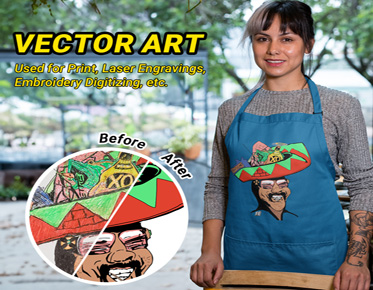Step-by-Step: Utilizing GIMP for Converting PDFs to Vectors
In the digital
age, graphic formats' versatility can empower or stifle creativity. While PDFs
are ubiquitous for their reliability in document sharing, their rigid structure
can limit artistic endeavors. The ability to convert these files into vector formats opens possibilities, particularly for
designers seeking scalable graphics. graphics
offer unparalleled flexibility, retaining sharpness regardless of size. So why
not harness the power of GIMP, a robust and free image manipulation program, to
facilitate this transformation? This guide explores the ins and outs of using
GIMP for converting PDFs to vector formats, ensuring your designs can soar to
new heights.
The Benefits of Using GIMP for Vector Conversion
GIMP, short for
GNU Image Manipulation Program, is a formidable ally in the quest for graphic
design excellence. Unlike other software that requires a hefty price tag, GIMP
is open-source and free to use, democratizing access to powerful design tools.
Its extensive range of features, from layers to paths, equips users with
everything they need for precise vector conversion.
Moreover, GIMP supports a variety of file formats, making it a versatile choice
for any project. With a user-friendly interface and an active community
offering resources and plugins, GIMP stands as a beacon for those venturing
into the world of vector graphics.
Opening PDFs in GIMP
How
to Import PDFs into GIMP: The First Steps
Now that you’re
familiar with GIMP's layout, it’s time to import your PDF file. Navigate to
“File” in the top menu and select “Open.” Browse your computer to find the
desired PDF, and click “Open.” GIMP will present an import dialog box that
allows you to choose which pages to import, making it possible to work on a
single page or multiple pages as needed.
Understanding
the Import Dialog: Choosing the Right Settings
The import dialog
is where the conversion process begins in earnest. You’ll see options to adjust
resolution, which plays a crucial role in the quality of your output. Higher
resolutions yield better detail but increase file size, so find a balance that
suits your project’s needs. Opt for 300 DPI for high-quality prints or 72 DPI
for screen display. Consider whether you want to import each page as a separate
layer or combine them into one.
Adjusting
Image Resolution for Better Quality
Click
"OK" to import after making your choices. GIMP will bring the PDF
into the workspace, allowing you to examine the resolution. If the quality
seems lacking, you may need to return to the import settings and adjust the DPI
for future imports. This attention to detail at the outset can save significant
time in the editing process later on.
Preparing Your PDF for Conversion
Analyzing
Layers and Elements: What to Look For
With your PDF now
in GIMP, take a moment to analyze its layers and elements. If your PDF is
complex, it may contain numerous layers that require individual attention. Look
for text, images, and other graphic components that may need tracing or
modification. Understanding what elements exist in your PDF will inform your
approach as you prepare for conversion.
Cropping
and Resizing Your PDF for Optimal Results
Before diving
into the conversion process, consider whether cropping or resizing your PDF is
necessary. Use the crop tool to eliminate any extraneous elements that may
detract from your main focus. This step can help create a cleaner workspace,
allowing your vector conversion to shine. Additionally, if the dimensions of
the PDF don’t suit your project, resizing it now will save you from future headaches.
Enhancing
Image Quality: Cleaning Up the PDF Before Conversion
Cleaning up your
PDF is essential for achieving optimal results. Use GIMP’s editing tools to
remove any unwanted marks, artifacts, or blemishes that may have transferred
from the original PDF. A cleaner image will yield a more precise vector,
ensuring your final product is polished and professional.
Using GIMP's Tools for Vector Conversion
The
Magic of the Path Tool: Creating Vector Paths
The path tool is
your best friend when it comes to vector conversion.
This powerful feature allows you to create precise vector paths by clicking
around the desired shape, forming a series of connected points. Don’t be afraid
to zoom in for accuracy—precision is key! Once you’ve traced your desired shape,
you can easily manipulate the paths for curves and angles, ensuring your vector
graphic maintains its integrity.
Using
the Free Select Tool: Tracing Elements with Precision
For elements that
are less geometric and more organic, the free select tool can be invaluable.
This tool allows for freehand selection, giving you the flexibility to trace
intricate designs or irregular shapes. Click to create points around your
desired area, or drag to draw freehand. Once your selection is complete,
convert it to a path for further manipulation.
Transforming
Selections: Scaling, Rotating, and Aligning
GIMP offers
powerful transformation tools that enable you to scale, rotate, and align your
selections effortlessly. Once you’ve created your paths, utilize the
“Transform” menu to make adjustments. This functionality is crucial when aiming
for precision in your designs, allowing you to ensure that each element aligns
perfectly with your vector composition.
Converting PDF Elements to Vectors
Step-by-Step:
How to Trace Images and Text
Converting PDF
elements to vectors requires a methodical approach. Start by selecting your
desired image or text with the appropriate tool, then convert your selection to
a path. If tracing text, consider the font style and ensure you replicate it as
closely as possible. For your design to remain intact, this step is essential.
Working
with Shapes and Colors: Filling and Outlining Paths
Once your paths
are established, it’s time to play with shapes and colors. Use the fill tool to
add color to your vector shapes, and consider using the stroke tool for
outlines. The right color choices can dramatically enhance your design, giving
it depth and vibrancy. Experiment with gradients and patterns to elevate your
graphic further.
Combining
Layers: Merging Elements for a Cohesive Vector Image
As you work,
you’ll likely have several layers created from different paths and selections.
To achieve a cohesive vector image, consider merging these layers. This can
streamline your project and make it easier to manage. Simply select the layers
you wish to combine, right-click, and choose “Merge Layers.” The result is a
unified design that’s easier to manipulate.
Exporting Your Work
How
to Save Your GIMP Project Before Exporting
Before exporting
your masterpiece, don’t forget to save your GIMP project. Go to “File” and
select “Save As,” ensuring you keep an editable version of your work. GIMP’s
native format (.XCF) preserves layers, paths, and other essential components,
allowing you to revisit and modify your project in the future.
Exporting
to Vector Formats: Choosing the Right Settings
When you’re ready
to export your finished vector graphic, navigate to “File” and select “Export
As.” Here, you can choose your preferred vector format—commonly SVG or EPS.
Each format has its strengths, so consider your end goal. SVG is ideal for web
applications, while EPS is often preferred for print.
Understanding
File Types: SVG vs. EPS vs. Others
Understanding the
differences between file types is essential for effective exportation. SVG (Scalable
Vector Graphics) is widely supported across web platforms, making it suitable
for digital design. EPS (Encapsulated PostScript) is favored for print media,
as it maintains quality during scaling. Other formats, like PDF and AI, also
have their places depending on your project needs. Choose wisely to ensure
compatibility with your intended use.
Post-Conversion Adjustments
Editing
Your Vector Image in Other Software: When to Use Inkscape or Illustrator
While GIMP is a
powerful tool, certain post-conversion adjustments may be better suited to
specialized software like Inkscape or Adobe Illustrator. Consider transferring
your project if your design requires advanced vector manipulation or intricate
detail. Both platforms offer features tailored to vectordesign, allowing you to refine your work even further.
Fine-Tuning
Colors and Shapes: Making Your Vector Image Pop
Fine-tuning your
vector image involves more than just color selection. Pay attention to
gradients, shadows, and highlights to add depth and dimension. Experiment with
color theory to create striking contrasts that make your design pop. A
well-thought-out color scheme can elevate your work from average to
extraordinary.
Adding
Text and Additional Graphics: Enhancing Your Design
Once your main
elements are complete, consider enhancing your design with text and additional
graphics. Select appropriate fonts that complement your overall aesthetic, and
ensure they’re legible in various sizes. Don’t hesitate to incorporate
decorative elements, shapes, or icons that enrich your design, adding layers of
visual interest.
Troubleshooting Common Issues
Dealing
with Low-Quality Outputs: Tips for Better Resolution
If you’re facing
low-quality outputs, revisit your initial PDF settings. Ensure you imported
your PDF at a high enough resolution to maintain clarity during conversion.
Additionally, be mindful of the size and scale of your vector paths—larger
dimensions can often mitigate blurriness.
Fixing
Path Errors: Common Mistakes and How to Avoid Them
Path errors are
common pitfalls in vector design. Overlapping paths or incorrectly closed
shapes can lead to complications during export. To fix these issues, utilize
GIMP's “Path Tool” to inspect each path meticulously, ensuring they’re clean
and properly connected.
Understanding
Color Profiles: Ensuring Consistent Color Across Formats
Color profiles
can be perplexing, but they’re essential for ensuring consistency across
formats. Familiarize yourself with RGB and CMYK color modes, as they serve different
purposes. RGB is typically used for digital designs, while CMYK is standard for
print. Be diligent in checking your color profiles before exporting to avoid
unexpected discrepancies.
Understanding Limitations and Challenges
What
GIMP Can and Can’t Do: Recognizing the Boundaries
While GIMP is a
powerful tool, it’s essential to recognize its limitations. Certain advanced
vector features found in dedicated software may be lacking. Understanding what
GIMP excels at—like image manipulation and basic vector creation—versus what it
struggles with can help set realistic expectations for your projects.
Handling
Complex PDFs: Strategies for Managing Difficult Files
Complex PDFs can
pose significant challenges during conversion. To manage these files effectively,
break them down into smaller components. Import one layer or section at a time,
allowing for greater control and clarity. Patience is key when dealing with
intricate designs—take your time to ensure accuracy.
Alternative
Methods for PDF to Vector Conversion: When to Consider Other Tools
In some
instances, alternative PDF to vector conversion
methods may be warranted. Online converters or dedicated vectorization software
can provide quick solutions for simpler tasks. Assess the complexity of your
project to determine whether GIMP or another tool is the best fit.
Transforming PDFs into vectors using GIMP is not only a practical solution for graphic designers but also an empowering skill for anyone looking to enhance their digital artistry. By following the outlined steps, you can effectively unlock the full potential of your PDFs, allowing for greater flexibility and creativity in your projects. Embrace the versatility of GIMP and elevate your design workflow by seamlessly integrating vector graphics into your artistic repertoire.



